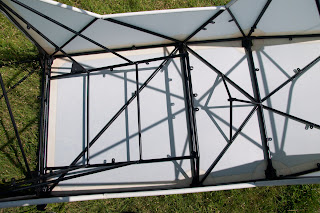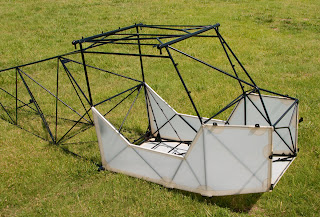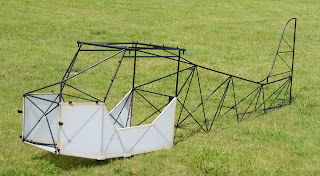Rear Fuselage Final Assembly
By James Wiebe, Belite Aircraft
After the rear aluminum fuselage has been attached to the aluminum cabin, several important details remain. They include:
a) Vertical Stabilizer Attachment
b) Horizontal Stabilizer Attachment
c) Elevator push pull tube Attachment
d) Gas Tank Compartment Assembly
Each is fairly easy to do. Let's get to work.
VERTICAL STABILIZER ATTACHMENT
The vertical stabilizer slips into the rear tube on the fuselage:
 |
| Vertical Stabilizer slipped into the fuselage |
A hole is then drilled for a pin. We use a AN3 pin (3/16" diameter) to slip the drilled home.
 |
| Hole drilled for AN3 pin. |
The front of the vertical stabilizer is attached to the fuselage using a couple lengths of 1" square aluminum tubing.
 |
| 1" square tubes clamped in place |
 |
| 1" square tubes clamped in place |
The horizontal stabilizer is attached to the steel straps. The critical factor is the angle of incidence of the rear elevator; to determine this, first level the fuselage (using levels at the cabin) then make sure that you set the horizontal stabilizer at an angle of 3 degrees negative incidence. This means that the leading edge is lower than the trailing edge. If you are assembling a taildragger, this means that the rear of the fuselage will be off the ground by around 15 or 20 inches, so that the airplane is level as measured at the cabin. The airplane must also be leveled if you are assembling a tricycle gear airplane. This normally requires shimming the nose wheel up slightly.
 |
| Horizontal Stabilizer in place, front bolt position determined by angle of incidence. Elevator also is attached and drooping. |
 |
| Horizontal Stabilizer, front and rear bolt shown. |
The attachment of the flying wires is covered elsewhere in this manual. A bottom cross connector flying wire plate is made from two pieces of aluminum,
(PHOTO TO BE SUPPLIED of BOTTOM CROSS CONNECTOR FLYING WIRE PLATE),
and is attached with AN3 bolt to the bottom aluminum plate.
Here's one more photo of the horizontal stabilizer, with the rear bolt attached. Also note that the elevator has been test fitted using AN3 clevis pins.
 |
| Rear Elevator Bolt Detail. Length of strap may be adjusted to set correct angle of incidence. Elevator also attached. |
ELEVATOR PUSH PULL TUBE ATTACHMENT
The rear elevator push pull tube is either 0.750 of 0.875 inches in diameter, and is constructed of aluminum. It is rough cut to length, so that a neutral stick, and a neutral reversing bellcrank, and the elevator position is neutral, all at the same time. Here are pictures demonstrating all of these requirements:
 |
| Neutral stick position |
 |
| Neutral reverser bellcrank with elevator push pull tube attached |
 |
| Neutral Elevator, looking forward through fuselage |
The push pull tube contains a machined and threaded insert at each end, which is held in place with 3M 2216 adhesive, and a single AN3 bolt, drilled through the insert. When it is cut to the proper length, everything is neutral, as shown in the above photos.
A diagonal member is placed and riveted on the internal fuselage frame, with a nylon or poly plastic block clamped in place. The proper diameter of the hole through the bearing block is 0.125" greater than the diameter of the push pull tube. For instance, for a 0.75" push pull tube, drill a 7/8" hole. After positioning for perfectly frictionless movement, the block is then held in place with a couple of AN3 bolts, washers, and locknuts.
 |
| Diagonal with bearing block |
GAS TANK COMPARTMENT ASSEMBLY
In order to construct the base of the gas tank compartment, a length of 7/8" by 1/2" angle aluminum is riveted to the rear of the fuselage cabin. Then 3 cross members are riveted in place, followed by attachment of a aluminum sheet bottom. Note that this compartment clears the top of the elevator push pull tube by about 1/2". If it does not, the base level is too low and must be raised.
 |
| Angle aluminum across rear base of cabin and 3 cross members |
 |
| Clearance from elevator push pull tube below gas tank compartment |
 |
| Aluminum skin placed in position |
 |
| Aluminum skin riveted in place |








































